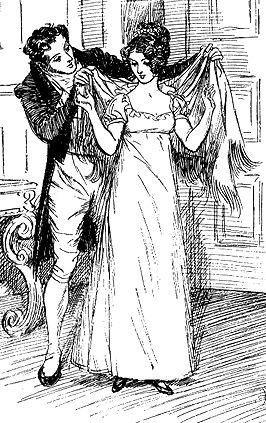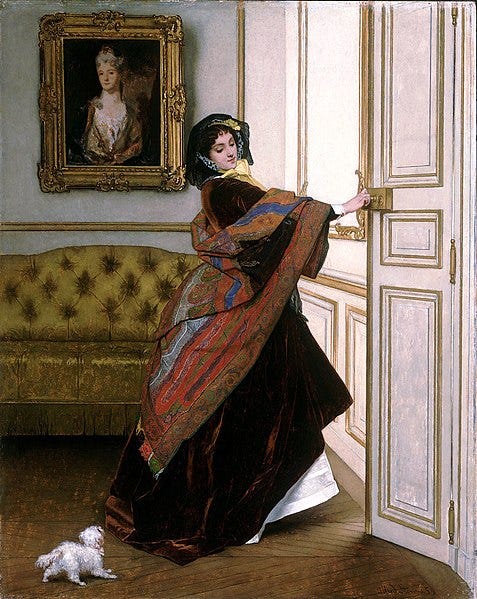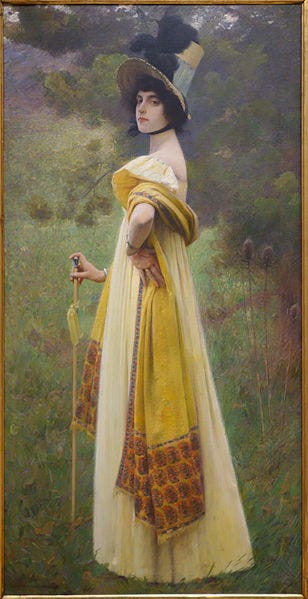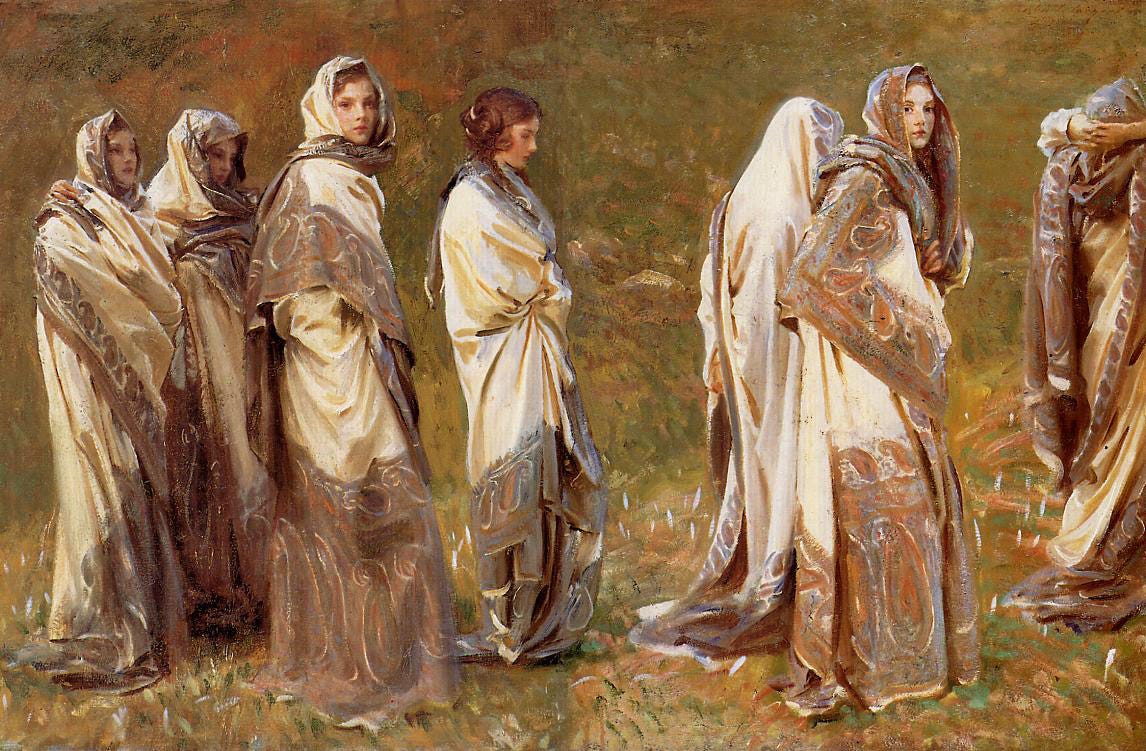Cocooned in Colonial Comforts: Kashmir Shawls in Jane Austen's 19th Century
"...The Kashmir shawl can be read as exemplifying the tension between colonialism, consumerism, and class comforts in vivid and tactile form..."
Note: This is an adapted and extended version of an academic essay I wrote last month for a college composition class. I found the topic intriguing and thought others might as well. Enjoy!
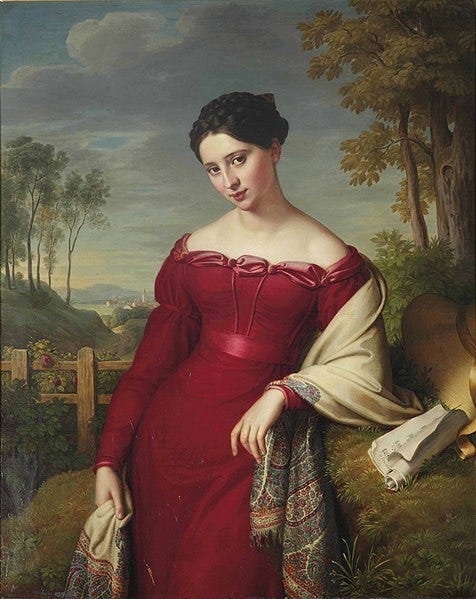
Imagine the faint but sharp smell of cedar wood over the sweet muskiness of wool. Imagine the deepest shade of sunlit wine-red, scrolled with tendrils and twists of jewel-toned thread. Imagine it blanketing you, heavy and a little rough against your shoulders in a candle lit room. And imagine it carrying with it the love of a husband or father, brother or lover– love that crossed dangerous seas and exotic, luminously imagined lands full of hostile wonder. This is a Kashmir shawl, which was en vogue throughout much of the 19th century, and single-handedly inspired an entire domestic industry in imitation of its splendor and popularity. But what else must be imagined to gain a full picture of a Kashmir? And what can be drawn in symbolic importance from the wearing or literary reference of its tightly woven, finely wound goat’s wool yarn?
A garment can communicate a world of information via color, texture or trend, much like a careful word choice in a poem or novel imbues shades of expressive meaning. While the message conveyed in a chosen clothing item may not be readily apparent to a careless viewer, or even be subconscious on the part of the wearer, it nonetheless is nestled among the semiotics of a complex web of cultural background. (Lundèn, 249). Such a garment is the Kashmir shawl, woven by native craftsmen originally for trade among male nobility and imported to the West (where they quickly became ubiquitously popular) by colonial forces (Dolan). After arriving in France and England, they transformed into a feminine garment, despite their origins (or, perhaps, as a subtle indicator of Western men’s scorn for the men they had overcome). Wrapping their wearers in physical opulence and warmth, while– in a less literal way– insulating and distracting the wearers with their rich beauty from the ugly realities of their colonial origins, the Kashmir shawl is a potent symbol of the tension between comfort and colonialism in 19th century fashion, especially as referenced by Jane Austen.
While they were already being traded in earlier decades, when they were brought back to France by Napoleon and popularized by Empress Josephine, they took on a cultural mystique and message of their own (Dolan, p. 412, 419). These shawls were a defining trend throughout much of the 19th century, inspiring an entire domestic British industry in imitation (Zutshi, pp. 423-424), and exuding as much social impact as the most coveted designer bags (or their imitative knockoffs) of modern times (Dolan pp. 417-419). Shawls became important currency in the game of love and sex, as well as signals of status and style among social groups.
Created of luxurious fibers and dripping with jewel tones and intricate patterns, they appealed to the ornate and influential sensibilities of the opulent Empress in their ostentatiously oriental style (Cole) and while at first mainly upper-class women emulated her in this status-symbol trend, as domestic production of imitation shawls known as Paisleys increased, the trend became democratized and available to middle and lower class women as well. Romanticized interpretations of Classical and Orientalist themes were fashionably exotic, reflecting the exploration and in many cases misinterpretation of a newly exciting exposure to ancient and eastern cultures.
Simple, daring column dresses inspired by the draping of Greco-Roman statuary and embraced in the pendulum swing away from pre-revolution rococo excess were the defining look of the first few decades of the 19th century. These were accessorized– and warmed– by the boldly dyed folds of these shawls, contrasting or complimenting their design depending on the wearer’s taste or the decades demands. This fascination with eastern design extended throughout much of the century, into the Victorian era, as sensibilities informed by colonialism were juxtaposed with domestic, civilized pride (Zutshi, pp. 433-444, 437). But despite the rampant stylistic derivation from Western domination in the East, how much did the literature and attitude of the time grapple with the source of these aesthetics? For instance, what does one of the foremost, fashionable literary voices from that era have to say?
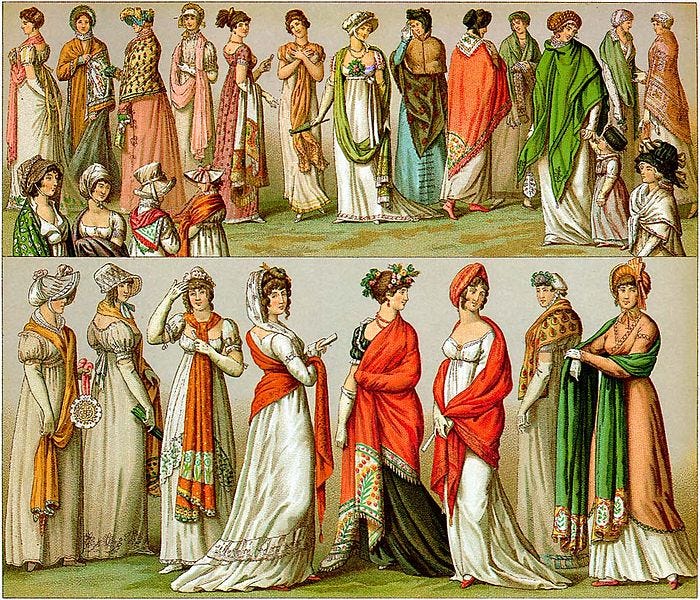
In Edward Said’s book Culture and Imperialism, he devotes a chapter to exploring Jane Austen’s novel Mansfield Park from a critical, anti-colonial perspective in which the implicit, unspoken reality of colonialism as the backdrop of the culture of its time is drawn out of textual clues (Said, pp. 96-97). He argues that contemporary 19th century literature serves to enforce colonialism as an unproblematic norm, a norm unchallenged by the authors and enshrined in a literary canon that can only see its collective cultural relationship with the East through an uncritically Orientalist lens. While respecting Austen as an author, he views her as not caring about or commenting on colonialism outside of its being an incidental context to her world of class and comedy of manners. As such, he reads the Bertram family as symbolic of the impossibility of their class and lifestyle without the violent slave labor and commercial trade that Sir Thomas, the family patriarch, is engaged in. Fanny Price, the novel’s heroine, is (in Said’s reading) her own specific symbol of a “transported good” whose arc from poverty and ignorance to wealth and good breeding mirrors the exploitation and wealth production of ”colonial movements”(Said, pp. 88-89). By examining the text and its position in the literary canon, as well as its historical and social context, Said utilizes Austen’s “rich work” (p.96) to draw conclusions about both the novel itself and the attitudes toward colonialism it both displays and influenced (p. 84). In Decolonizing imperialist discourse in Jane Austen’s Persuasion: A Saidian reading, the authors extend Said’s approach to similarly examine implicit imperialist and colonial themes in another of Austen’s works, arguing like Said that it is impossible to separate her work from it’s supposedly subconscious enforcement of imperialism and violence.
By following Said’s literary line of thinking when more broadly considering the popular culture of the mid-19th century, we begin to see a dark thread of colonial violence tangled underneath the vibrant patterns of upper class luxury and lifestyle. In this way, then, the Kashmir shawl can be read as exemplifying the tension between colonialism, consumerism, and class comforts in vivid and tactile form– it becomes a potent visual symbol, a luxury item that confers both comfort and status yet does so from roots in violent colonial wealth and theft of resources.
In particular by examining this garment in dialogue with Said’s lens of Austen’s work, a sobering picture of the ways in which fashion can enable its consumer to both literally and figuratively wrap themselves in beauty while ignoring the ugliness that produces it can be drawn in the specific context of 19th century sensibilities. Conspicuous consumerism can be a means of explicitly signaling a certain morality (or lack thereof (Dolan, p. 424)), though at times such messaging can be subconscious or skipped over as frivolity by readers. However, in my opinion, Said’s view flattens the insight of Austen about her own characters and context. When referenced in one of her defining and sharply-observed literary works, by the pen of a woman who was keenly thoughtful about the material realities of her time, a shawl cannot be merely a shawl but becomes a symbolic prop charged with meaning.
Jane Austen was no stranger to utilizing fashion as subtextual communication (Margalit). In Pride and Prejudice, Caroline Bingley’s wry and disdainful remark about heroine Elizabeth Bennet’s muddy petticoat conveys a world of meaning far beyond that garment’s cleanliness– she is commenting not on a dirty hem but on Lizzy’s moral character and social position and in doing so is also revealing her own, all through one flippant observation about clothes. In our own time, we read styles and trends as indicative of a general type of their wearer– clothing is chosen more than ever before as a means of signaling something about your character and identity. Austen’s time was not so different, as contemporary fashion publications and her own letters show.
What might it mean, then, when in Mansfield Park, Kashmir shawls are directly mentioned by Lady Bertram, a passive and indolent mother who is defined by her diffidence towards her household and her children’s moral upbringing? Familiarity with Austen’s work and letters alerts a careful reader that this throwaway line of dialogue is in fact revelatory– in this case, about a certain kind of characteristic moral torpidity and self-absorption.
“Fanny, William must not forget my shawl if he goes to the East Indies... I wish he may go to the East Indies, that I may have my shawl. I think I will have two shawls, Fanny.” Lady Bertram, Mansfield Park (Austen, 246)
Not one but two shawls! Excess and selfishness are on display, here, as Lady Bertram both revels in the possible acquisition of multiple Kashmirs, but does it at the expense of Fanny’s feelings about her beloved brother William’s safety. If we believe (I’d argue rightly) that Jane Austen uses fashionable details in her work to make subtle points about both the characters and her society (Margalit), since Lady Bertram is far from a sympathetic character, is it possible that Said is wrong about Austen’s unawareness of the uneasy tension between upper class comforts and the colonialism that produced them? And that similarly, by presenting a dysfunctional and careless family who are indebted to their father’s slave plantation for the wealth that enables their foibles, she in fact paints a picture of the way that colonialism impacts the morality of societies and individuals that it supports, without heavy-handed direct moralism in-text? In combining Said’s anti-colonial reading with the insight of fashion history, a single line of Austen thus becomes rife with meaning- potent, intended meaning that is merely wrapped in the soft, seductive vibrance of a Kashmir shawl.
Further Reading:
A fascinating story of a quest to find and then replicate a Kashmir worn in several sittings for portraits by John Singer Sargent. Only related in the sense of the topic being Kashmir, but really interesting. Does anyone want to plan a trip to London to see the Sargent exhibit at the Tate (since I foolishly forgot to go when it was literally 4 hours away in Boston)?
I also highly recommend poking through portraits and photos of Kashmir and Paisley shawls on Google Images or Pinterest. Lots of loveliness to be enjoyed!
Works Cited
Abd-Rabbo, Muna, Ghadir Zalloum, and Ziad Nemrawi. "Decolonizing imperialist discourse in Jane Austen’s Persuasion: A Saidian perspective." Arab Studies Quarterly, vol. 45, no. 3, 2023, pp. 229-243.
Austen, Jane. Mansfield Park. The Folio Society, 1989.
- - -. Pride and Prejudice. The Folio Society, 1989.
Cole, Daniel James. “Hierarchy and Seduction in Regency Fashion.” Persuasions: The Jane Austen Journal On-Line. Vol. 33, No.1, 2012.
Dolan, Therese. “Fringe Benefits: Manet’s Olympia and Her Shawl.” The Art Bulletin. Vol. 97, No. 4, 2015, pp. 409-429.
Lundén, Elizabeth Castaldo. “Exploring Fashion as Communication: The Search for a new fashion history against the grain.” Popular Communication, vol. 18, no. 4, Routledge, 2020, pp.249-258.
Margalit, Efrat. "On Pettiness and Petticoats: The Significance of the Petticoat in Pride and Prejudice." Persuasions : The Jane Austen Journal On-Line, vol. 23, no. 1, 2002.
Said, Edward. Culture and Imperialism. Knopf, 1993.
Zutshi, Chitralekha."“Designed for eternity”: Kashmiri Shawls, Empire, and Cultures of Production and Consumption in Mid-Victorian Britain." Journal of British Studies, vol. 48, no. 2, 2009, pp. 420-440.





